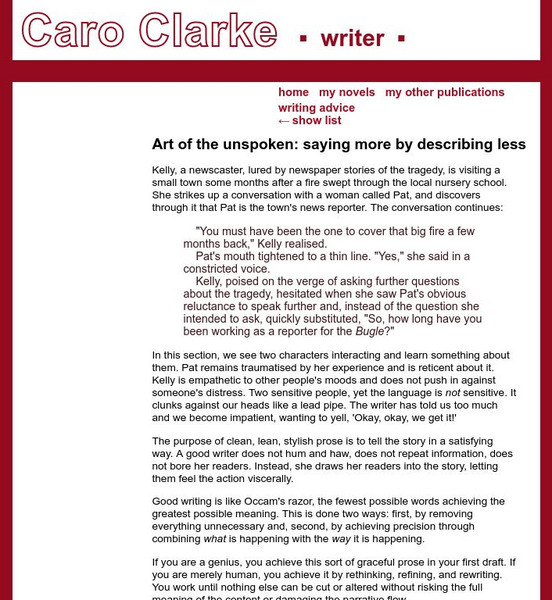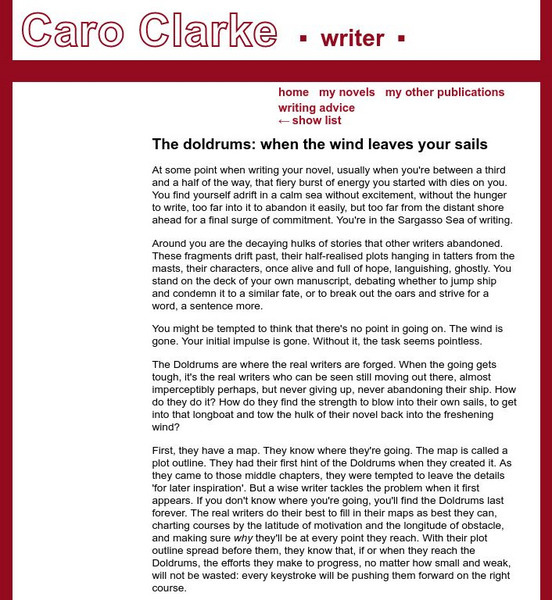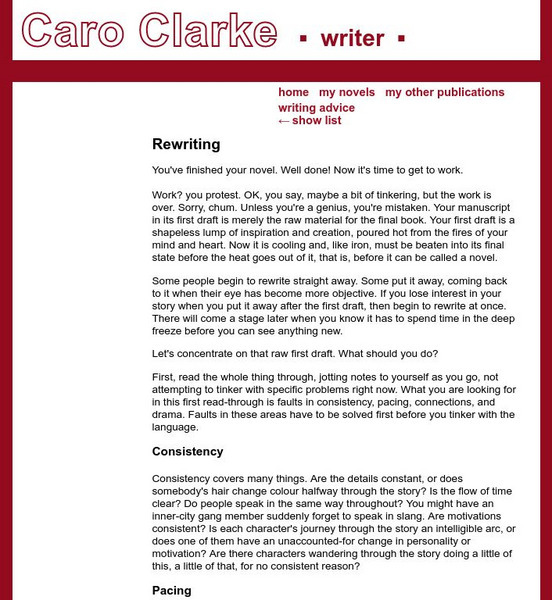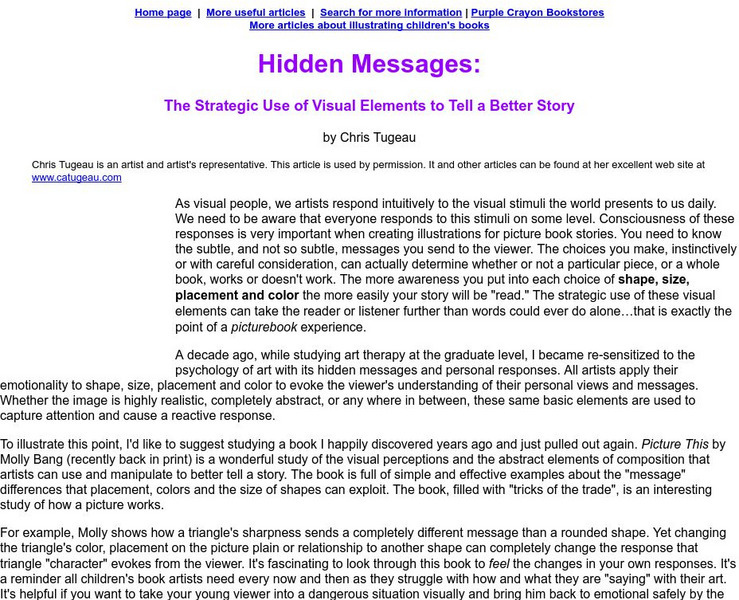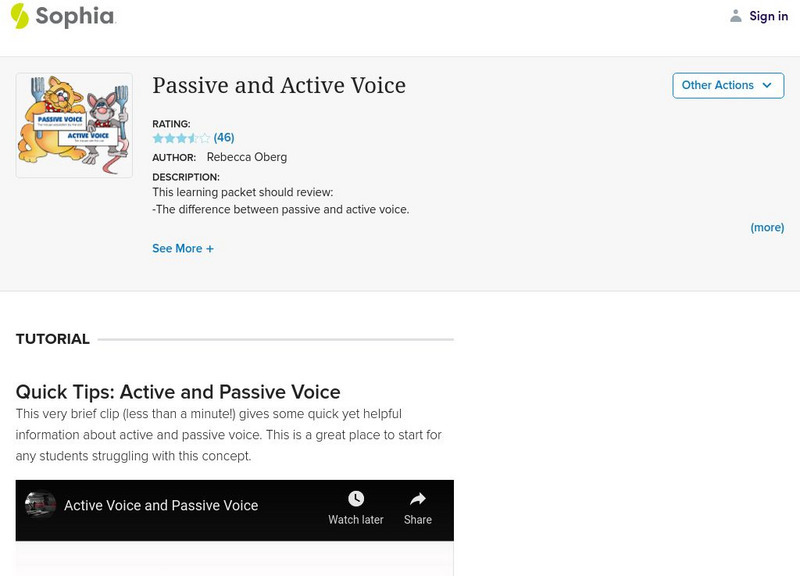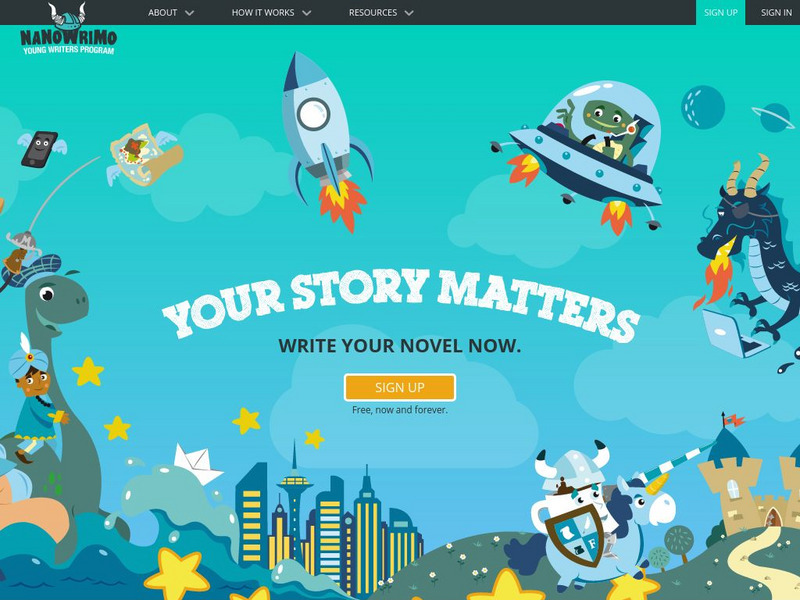Caro Clarke
Not Stopping the Reader: How to Avoid Stumbling Blocks
This is the eighth article in a series that focuses on helping the new novel author. This article looks at how the author can avoid creating stumbling blocks that disrupt the flow of the novel.
Caro Clarke
Explaining Too Much: Why More Is Less
This is the eleventh article in a series that is designed to help the new novel author. This article focuses on how to eliminate needless information in your novel. The key is to not explain too much about the action.
Caro Clarke
The Art of the Unspoken: Saying More by Describing Less
This is the thirteenth article in a series that was developed to help the new novel author. This article focuses on how good descriptions aren't necessarily connected with a lot of words, good descriptions are clean and to the point.
Caro Clarke
Historical Fiction: Who Rules?
This is the fifteenth article in a series designed to help the new novel author. This article focuses on the genre of historical fiction and the role of the author. Is the author a researcher or a story-teller?
Caro Clarke
The Doldrums: When the Wind Leaves Your Sails
This is the 16th article in a series that gives advice to the new novel writer. This is a particularly interesting and helpful article on how to deal with periods in writing when your enthusiasm wanes.
Caro Clarke
Rewriting
This is the 17th article in a series that helps the new fiction author with the final step--revision.
Harold D. Underdown
The Use of Visual Elements to Tell a Better Story
Short article gives excellent tips concerning how to use visual elements to enhance a written story. Article was written specifically for children's literature, but can also apply to other genres as well.
Washington State University
Washington State University: Common Errors
Do you say or write "exscape" when you should say "escape"? This webpage is from the Common Errors in English website. If you think other people's language mistakes are sometimes funny, you might enjoy reading the ways people have...
Utah Education Network
Uen: 1st Grade Act. 24: Interactive Writing
In this instructional activity, young scholars will listen to nonfiction books about items that sink and float. Students will participate in filling in words to fill in a teacher-created chart that is connected to the information. Young...
Utah Education Network
Uen: Writing Numerals
This multisensory lesson engages students in reading and writing numbers that are less than 20. Students will learn songs, watch video segments, and engage in tactile exercises related to writing numbers.
Sophia Learning
Sophia: Passive and Active Voice
This website provides two presentations on active and passive voice. The first presentation explains the difference between active and passive voice as well as how to build sentences in each voice. The second presentation explains when...
Sophia Learning
Sophia: Passive and Active Voice
This tutorial focuses on active and passive voice. Definitions, examples, and the reasons that the active voice is the preferred voice in most cases. It offers a slide show with definitions, examples, when to use, forms of passive voice...
Annenberg Foundation
Annenberg Learner: Workshop 1: Creating a Community of Writers
Workshop 1 explores the components of a community of writers and what teachers can do to create and foster such a community. After a brief introduction to the goals of all eight workshop sessions, middle school teacher and writing expert...
University of Minnesota
Minnesota Writing Project: Newsletters and Annual Updates
This resource is an archive of the Minnesota Writing Project Newsletters.
Free Management Library
Management Assistance Program: Guide to Ethics Management
This website has an extensive discussion on business ethics. The article discusses two broad areas of business ethics, management discipline, and 10 myths about business ethics.
Colorado State University
Writing@csu Guide: Understanding Writing Situations
In this guide, you can learn more about the situations in which writers and readers find themselves and the physical, social, cultural, and historical contexts that shape them. Click on each of the links on the right to learn about the...
Archaeological Institute of America
Shang City Uncovered
This article describes the early excavation successes of the American-Chinese archaeological partnership, the Anyang Project.
Other
Nanowrimo: National Novel Writing Month for Young Writers (November)
This is a young writers program offering information and resources for young writers and educators.
Teachnology
Teachnology: A Variety of Printable Handwriting Worksheets
Use this resource to print activities and worksheets for handwriting.
Other
Fiction Writing Tips: Creating a Vivid Setting
Some excellent guidelines to consider when evaluating your setting in a short story or novel. Discusses the importance of setting, some examples, as well as practical advice in setting your story. W.11-12.3d Sensory/precise lang narratives
Caro Clarke
Caro Clarke: Description: What's It For?
This is the twelfth article in a series that is designed to help the new novel writer. This article focuses on how to effectively use descriptions in any writing.
ReadWriteThink
Read Write Think: Thoughtful Threads: Sparking Rich Online Discussions
Today's learners love chatting online with friends. This lesson combines that love with literature. Students form literature circles and have meaningful online discussions about a literary work.
Capital Community College Foundation
Guide to Grammar and Writing: Parallel Form
This site from the Capital Community College defines the term and gives many examples of faulty parallelism and the corrected version of sentences. Includes links to a couple of quizzes at the bottom of the page. "Most of the...
ReadWriteThink
Read Write Think: Digging Up Details on Worms: Using Science in an Inquiry Study
A lesson plan based on a study unit of earthworms, using the inquiry model to integrate scientific processes with literacy practices. Instruction plans, related resources, and standards are included.




